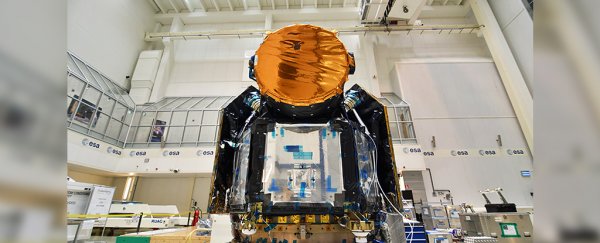A new space telescope is expected to take an unprecedented look at some of the 4,000 mysterious planets scientists have discovered outside our Solar System. But its launch was suddenly postponed on Tuesday.
The CHaracterising ExOPlanets Satellite (CHEOPS) was scheduled to launch Tuesday morning from Kourou, French Guiana at 5:54 am local time.
However, just 1 hour and 25 minutes before liftoff, the automated launch sequence of the Soyuz-Fregat rocket that would carry it to space was interrupted. The rocket was also carrying an Italian defence satellite and five nano-satellites called CubeSats.
Arianespace, the satellite company overseeing the launch, said in a statement that the launcher and its cargo were in a "fully safe standby mode" and that a new launch date will be announced as soon as possible.
CHEOPS aims to take a closer look at planets smaller than Saturn. Its camera lens, which measures 32 centimeters (12 inches) in diameter, is designed to study the size and mass of known exoplanets (the term for worlds outside our Solar System).
Importantly, CHEOPS will also look for atmospheres on those far-away worlds – a requirement for any planet to host life.
A new tool for studying exoplanets
Like other space telescopes, CHEOPS will watch for tiny dips in stars' brightness that are caused by planets passing in front of them – called transits. Unlike previous telescopes, however, CHEOPS will not scan the skies for never-before-seen transits.
Instead, it will focus on bright stars that scientists already know are orbited by planets between the size of Earth and Neptune.
By measuring the radius and mass of these planets as they pass between Earth and their stars, CHEOPS will allow scientists to figure out whether the worlds are gaseous, like Neptune, or rocky, like Earth.
The space telescope could also determine whether some planets have atmospheres. That could enable the worlds to support liquid water (and, therefore, alien life) on their surfaces.
Additionally, CHEOPS will look for any planets that past telescopes may have missed in known star systems and attempt to discern visible features like rings or moons.
All this information will help scientists identify planets that future telescopes could study for signs of life.
CHEOPS is the first of the European Space Agency's 'S-class missions', which will cost under 50 million euros (US$55.7 million).
Beyond observations that are already planned and scheduled, the ESA will allot 20 percent of the telescope's time to scientists who have applied to use it for specific projects.
This article was originally published by Business Insider.
More from Business Insider:
